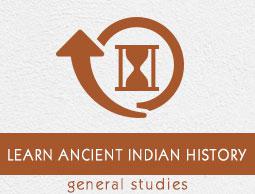After the death of Kakusthavarman, the Kadamba family split into two branches. One of the branches continued to rule from Banavasi and the other branch ruled from Triparvata.
Krishnavarma-I, the ruler from Triparvata, united the family. But around A.D. 540, the Chalukyas of Badami defeated the Kadambas and captured their kingdom.
In the southern Peninsula, three dynasties namely the Pallavas, Pandyas, and the Cholas were the major powers during this period.
The Pallavas became prominent after the fall of Satavahanas from the 3rd century until the rise of Cholas in the 9th century A.D. However, the origin of Pallava is under debate.
The Pallava kings were divided into two groups namely the early Pallavas and greater Pallavas.
The Tamil and Sanskrit inscriptions tell about the early Pallavas. It is mentioned that they performed sacrifices and ruled over a well organized territory that covered the northern part of the Peninsula extending from the eastern sea to the western sea.
Simhavishnu was the famous Pallava king ruling in the 6th century A.D. He increased the influence and prestige of his family.
Simhavishnu’s son and successor Mahendravarman-I (A.D. 600-630) was a versatile genius. He was both a poet and a singer.
Mahendravarman-I composed a play ‘Mattavilas Prahasana’ (the Delight of the Drunkards) in Sanskrit.
During this period, the practice of scooping entire temples out of solid rock was introduced.
The ‘Rathas’ of Mahabalipuram are fine examples of rock cutting temple.
Mahendravarman-I was the contemporary of the Chalukya king, Pulakesin-II and Harshavardhan of Kanauj.
During this period, Pulakesin-II had struggled with Harsha on the one hand and with Mahendravarman-I on the other. In both Pulakesin-II emerged victorious.
Pulakesin-II captured the northern provinces of Pallava’s kingdom after defeating Mahendravarman-I.
Later on, Pulakesin-II was defeated by Narsimhavarman. He was son and successor of Mahendravarman-I.
Narasimhavarman conquered Badami and adopted the title of ‘Vatapikonda.’
Narasimhavarman had also defeated the Cholas, the Cheras, the Pandyas, and the Kalabhas.
Narasimhavarman gave political refuge to a Ceylonese prince Manavarman and sent two naval expeditions to Ceylon to help him to secure the throne again.
Narasimhavarman was one of the most powerful rulers of south India and raised the power and prestige of the Pallavas as far as Ceylon and South East Asia.
Narasimhavarman-II ruled peacefully during the A.D. 695-722.
During this period, a particular style of temple architecture was developed. This is popularly known as the ‘Dravidian’ style of temple architecture.
Pallavas faced attacks from the Chalukya king Vikramaditya-II (A.D. 733-745) during the first half of the 8th century. He is said to have overrun Kanchi thrice.
The Pallavas had also been condemned of Pandyas and Rashtrakutas during the reign of Dantivarman (around A.D. 796-840).
Because of the continuous struggles, the power of the Pallavas began to decline.
The Pallavas were succeeded by the Cholas. They also developed as the greatest imperial power in the south. They had influence over Ceylon and the South East Asian countries.



